Exponents
An exponent tells you how many times a number, known as the base, is multiplied by itself. For example, in the expression 53, the base is 5 and the exponent is 3. This means 5 is multiplied by itself 3 times, resulting in 5 x 5 x 5 = 125.
Rules for Exponents:
- Multiplying Powers with the Same Base: When you multiply powers with the same base, you add the exponents. For example, 52 * 53 = 55.
- Dividing Powers with the Same Base: When you divide powers with the same base, you subtract the exponents. For example, 54 ÷ 52 = 52.
- Raising a Power to a Power: When you raise a power to a power, you multiply the exponents. For example, (52)3 = 56.
Factors
A factor is a number that divides evenly into another number. For example, the factors of 12 are 1, 2, 3, 4, 6, and 12. Factors are pairs of numbers that, when multiplied together, result in the original number.
Finding Factors:
To find the factors of a number, you can use a method called "factorization". Start with the number 1 and find its pair such that when multiplied together, they result in the original number. Continue this process until you reach the original number itself. For example, to find the factors of 24, you start with 1 and find pairs such as (1, 24), (2, 12), (3, 8), and (4, 6).
Fractions
A fraction represents a part of a whole. It consists of a numerator (the top number) and a denominator (the bottom number). Fractions can be proper (numerator is less than the denominator), improper (numerator is greater than or equal to the denominator), or mixed (a whole number combined with a proper fraction).
Operations with Fractions:
- Adding and Subtracting Fractions: To add or subtract fractions, you need to have a common denominator. Once the denominators are the same, you can add or subtract the numerators and keep the denominator the same. For example, 1/3 + 1/6 = 2/6 or 1/2 - 1/4 = 2/4.
- Multiplying Fractions: To multiply fractions, you simply multiply the numerators together to get the new numerator and multiply the denominators together to get the new denominator. For example, 2/3 * 3/4 = 6/12.
- Dividing Fractions: To divide fractions, you multiply by the reciprocal of the second fraction. For example, 2/3 ÷ 1/4 is the same as 2/3 * 4/1 = 8/3.
Study Guide
Here are some key points to remember while studying Exponents, Factors and Fractions:
- Understand the basic concept of exponents and practice solving problems involving exponents.
- Learn how to find factors of a number using factorization and practice finding factors of various numbers.
- Master the operations with fractions and understand the importance of having a common denominator when adding or subtracting fractions.
- Practice solving word problems involving exponents, factors, and fractions to apply your knowledge in real-life scenarios.
◂Math Worksheets and Study Guides Seventh Grade. Exponents, Factors and Fractions

 Worksheet/Answer key
Worksheet/Answer key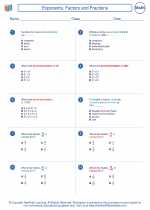
 Worksheet/Answer key
Worksheet/Answer key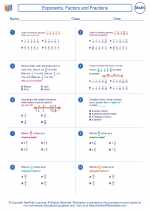
 Worksheet/Answer key
Worksheet/Answer key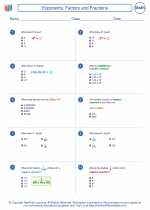
 Worksheet/Answer key
Worksheet/Answer key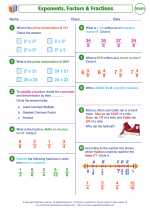
 Worksheet/Answer key
Worksheet/Answer key
 Worksheet/Answer key
Worksheet/Answer key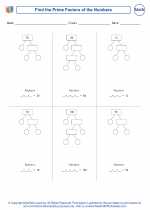
 Worksheet/Answer key
Worksheet/Answer key
 Worksheet/Answer key
Worksheet/Answer key
